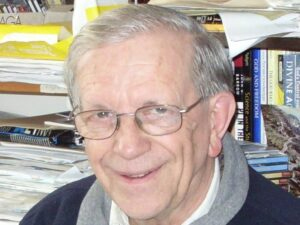 Anthony P. Stone obtained his first degree in Mathematics, as well as his PhD in theoretical physics, at the University of Oxford. Arriving in India in 1956, he taught mathematics at Indian universities from 1956 to 1975. That was, from 1956 to 1957, at Serampore University in Bengal – the very first university to have been established in India. Then, from 1957-1960, at Union Christian College, Aluva, Kerala, which had been established in 1921 for the purpose of nation building. Finally, Dr. Stone was, with interruptions, on the faculty of the University of Delhi (St. Stephen’s College) from 1961 to 1975.
Anthony P. Stone obtained his first degree in Mathematics, as well as his PhD in theoretical physics, at the University of Oxford. Arriving in India in 1956, he taught mathematics at Indian universities from 1956 to 1975. That was, from 1956 to 1957, at Serampore University in Bengal – the very first university to have been established in India. Then, from 1957-1960, at Union Christian College, Aluva, Kerala, which had been established in 1921 for the purpose of nation building. Finally, Dr. Stone was, with interruptions, on the faculty of the University of Delhi (St. Stephen’s College) from 1961 to 1975.
Having become intrigued with India’s obsession with astrology, he learned Hindi at Delhi University and Sanskrit at Bharatiya Vidya Bhavan. He also had a working knowledge of French, German, Greek, and Hebrew.
He was accepted as a Fellow of the Indian Association for History and Philosophy of Sciences, and as a Life Member of the Indian Mathematical Society as well as of the Indian Society for the History of Mathematics.
Most importantly, he was the Project Leader for the development of the international standard – ISO 15919:2001 Transliteration of Devanagari and related Indic scripts into Latin characters. Such transliteration is used in library catalogues, scholarly publications, and so on. The adoption of ISO 15919 has played a crucial role in bridging linguistic and script-based gaps, allowing for seamless exchange of information across different writing systems. The standard facilitated cross-cultural communication, research, and archival work, ensuring that valuable texts in Indic languages remain accessible to scholars, researchers, and enthusiasts worldwide. As of the 21st of May 2024, there is an ISO group working under the leadership of Mme Helene Xu of AFNOR, the ISO Member from France (helene.xu@afnor.org) and Editorial Manager, Mrs. Martha Casantosan (casantosan@iso.org), to develop something better. But the standard developed by Dr. Stone and his team is still the standard which is current, something like a quarter of a century after it was established – a testimony to the quality of Dr. Stone’s work.
